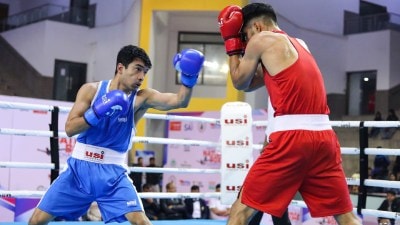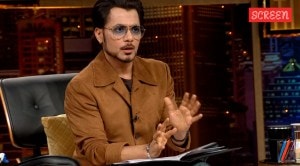It came as no surprise when the Atal Bihari Vajpayee-led National Democratic Alliance (NDA), a coalition of 20 parties, swept the 1999 general elections held between September 5 and October 3, 1999, after the Indian Army’s decisive win over its Pakistani counterparts in Kargil in July.

By the time a 75-year-old Vajpayee took oath as the Prime Minister for the third time on October 13, 1999, the next generation of BJP leaders had traded the wings for limelight. Then, during the July 2002 presidential elections, the BJP pulled a trump card in the form of “Missile Man” A P J Abdul Kalam. His candidature helped the BJP realign more forces.
Earlier, expelled from the Congress on May 20, 1999, along with two others for pointing fingers over Sonia’s foreign origins, a rebellious Sharad Pawar founded his own party, the Nationalist Congress Party (NCP), on June 10, 1999. While Sonia’s role during the 1998 polls was confined to mostly campaigning for the party, the Congress contested 453 of 543 seats in the 1999 elections under her leadership. Though the party’s seats dipped to an all-time low, Sonia would consolidate her position in the Congress and give the BJP a tough fight in the 2004 polls.
Polling and counting
Delayed due to the Kargil War, which ended on July 26, 1999, elections were finally held from September 5 to October 3. For the first time since Independence, an eight-phase schedule was announced. With three of these phases having just four seats in total, it was, in reality, just a five-phase poll — yet another first for the country. Counting of votes started on October 6, 1999, and the results were declared in the next few days.
Of 61.95 crore voters, 37.16 crore or 59.99% eligible adults voted. Among those, 29.57 crore were women. Of 4,648 candidates, 32 — the maximum — were in the fray from Gonda in Uttar Pradesh. Braj Bhushan Sharan Singh, the former president of the Wrestling Federation of India, won from Gonda on a BJP ticket. Of the 284 women contestants, 49 emerged as winners.
T N Seshan, the Chief Election Commissioner from December 12, 1990, to December 11, 1996, who is credited with having cleaned up the way polls were conducted in India, was fielded on a Congress ticket from Gujarat’s Gandhinagar against BJP’s L K Advani. However, the career bureaucrat lost to the veteran politician. Chandra Shekhar, the former Prime Minister, won from Ballia since the Samajwadi Party (SP) did not field a candidate against him, Vajpayee managed to retain his Lucknow seat and Murli Manohar Joshi won from Allahabad.
Story continues below this ad
Click here to read the other parts of this series on India’s Lok Sabha elections
The 1998 elections were the first in Independent India without a heavyweight candidate from the Nehru-Gandhi family, barring Maneka Gandhi, who won from Uttar Pradesh’s Pilibhit as an Independent. The 1999 elections saw Rajiv Gandhi’s wife Sonia Gandhi make her electoral debut from Uttar Pradesh’s Amethi and win.
BJP tally remains the same, Congress’s dips further
While the BJP repeated its 1998 tally this time too by winning 182 seats, Congress’s share deteriorated to 114 seats from 141 in 1998. The Communist Party of India (Marxist) won 33 seats, Telugu Desam Party (TDP) 29, SP 26, Janata Dal (United) 21, Shiv Sena 15, Bahujan Samaj Party 14, Dravida Munnetra Kazhagam (DMK) 12, Nationalist Congress Party (NCP), contesting its maiden general election since its formation by Sharad Pawar on June 10, 1999, and Mamata Banerjee’s Trinamool Congress eight each, Rashtriya Janata Dal seven and CPI four.
The results from Uttar Pradesh came as a shock for the BJP, where ego clashes between Vajpayee and Chief Minister Kalyan Singh ended up costing the party. Of the 85 seats in the state, the party’s share dropped to 29 in these elections against the 58 during the previous one. Despite this, Vajpayee managed to cobble together a majority — 303 seats — for his alliance.
Story continues below this ad
Vajpayee’s critics get the boot, Modi a foot in the door
The post-war glow faded fast when the BJP was hit by a series of embarrassing episodes. In 2001, undercover journalists decided to conduct a sting operation. It ended with Bangaru Laxman, BJP’s first chief from the Scheduled Caste (SC), getting caught on camera while allegedly accepting a bribe of Rs 1 lakh in his chamber at the party headquarters in exchange for his help with the fictitious defence deal.
The uproar ended when he tendered his resignation and was replaced by Jena Krishnamurti. Before that, three new states were created in India — Uttaranchal (later renamed Uttarakhand, by dividing Uttar Pradesh), Jharkhand (from Bihar) and Chhattisgarh (from Madhya Pradesh).
Meanwhile, during a meeting with some diplomats, K N Govindacharya, the Rashtriya Swayamsevak Sangh (RSS)-appointed general secretary (organisation) of the BJP, reportedly called Vajpayee the party’s mukhota (mask), adding that the “real leader” was party president L K Advani. His criticism of Vajpayee led to his ouster from the party.
Story continues below this ad
Though Govindacharya initially claimed that he was taking leave to study the impact of globalisation on the common man, he never returned to the BJP, nor was he defended by Advani or the RSS. Similar conflicts with Vajpayee led to Kalyan Singh’s removal, who was temporarily replaced by septuagenarian Ram Prakash Gupta. Rajnath Singh later replaced Gupta and served as Uttar Pradesh Chief Minister from October 2001 to March 2002.
In another big organisational shake-up in October 2001, incumbent Gujarat Chief Minister, BJP’s Keshubhai Patel, was asked to step down to make way for Narendra Modi, 51. In the BJP, Sanjay Joshi, then general secretary (organisation) of BJP’s Gujarat unit, replaced Modi as general secretary (organisation), a post held by RSS pracharaks.
Sonia fights detractors in Congress
The Congress too was busy putting out tiny flares of rebellion against Sonia, who took over as party president in March 1998 from Sitaram Kesri, who “resigned” after the Congress Working Committee (CWC) passed a resolution to the effect.
Her biggest critics in the Congress were Rajesh Pilot, a former Indian Air Force officer, and Jitendra Prasad, political advisor to former Prime Ministers, Rajiv Gandhi and P V Narasimha Rao, and the father of BJP leader Jitin Prasada.
Story continues below this ad
With polls for party president due in late 2000, Pilot and Prasad had both set their sights on the post. While Pilot died in a road accident in June 2000, Prasad contested against Sonia but got just 94 votes. With over 98% of the votes in her favour, Sonia had signalled her dominance over the party and its politics. Prasad passed away in January 2001.
Presidential poll and a surprise candidate
In an ingenious move to sideline all seasoned politicians eyeing the presidential chair, the BJP suddenly threw in the hat the name of Kalam, a pioneer of India’s missile programme. The Opposition proposed the name of Captain Lakshmi Sahgal, a former associate of Subhash Chandra Bose. With the support of SP’s Mulayam Singh Yadav and NCP’s Sharad Pawar, Kalam won the race. For the post of the Vice-President — and in a first for a BJP leader — Bhairon Singh Shekhawat, one of the founders of the Bharatiya Jana Sangh (BJS) like Vajpayee and Advani, was elected in August 2002.
His support to the BJP’s presidential candidate in 2002 reaped rich dividends for Mulayam when the BSP-BJP government collapsed in August 2003. A tacit understanding with the BJP saw the SP leader take oath as Chief Minister on August 29, 2003.
A generational change and baby steps towards a coalition
While BJP’s original leadership, active since BJS was founded in 1952, was getting older, the next generation was asserting itself in both the states and at the Centre. Consecutive victories in the Assembly elections in Gujarat (in 2002, Chief Minister Modi), Madhya Pradesh (in 2003, Chief Minister Uma Bharati, who was replaced by Babulal Gaur in August 2004) and Rajasthan (in 2003, Chief Minister Vasundhara Raje) added to the party’s confidence.
Story continues below this ad
A delimitation exercise was due, since a 1976 policy change had frozen parliamentary and Assembly constituencies till the 2011 Census. The Vajpayee government decided to continue freezing of seats within states till 2026 but the alliance gave its nod to rationalise boundaries of constituencies and the distribution of voters among constituencies within states. To effect this, a Delimitation Commission was constituted under retired Supreme Court judge, Justice Kuldeep Singh, in July 2002.
Meanwhile, Gujarat was ravaged by communal riots in February 2002, leading to severe criticism of Chief Minister Modi within the party too.
 Prime Minister Atal Bihari Vajpayee, Prem Kumar Dhumal and Narendra Modi. (Express archives)
Prime Minister Atal Bihari Vajpayee, Prem Kumar Dhumal and Narendra Modi. (Express archives)
One of Modi’s fiercest critics was former Himachal Pradesh Chief Minister Shanta Kumar. However, in a meeting of the BJP’s national executive in Goa in April 2002, second-generation leaders including M Venkaiah Naidu (future Vice-President) and Arun Jaitley (future union minister) were highly critical of the leaders criticising Modi. After the Goa meeting, which took place just before the July 2002 presidential polls, BJP chief Jena Krishnamurti was replaced by Naidu.
While the Congress was preparing for the next general elections by allying with other like-minded parties, the BJP was overconfident about winning once again without a real fight. Pramod Mahajan, a rising star, was relieved from the Vajpayee Cabinet on January 29, 2003, to help Naidu prepare for the 2004 general elections.
Story continues below this ad
The elections were due in September-October 2004, but young BJP leaders persuaded Vajpayee to advance the polls claiming the time was right for the party to win. The young Turks were convinced that their “India Shining” campaign, combined with the party’s “feel-good factor” among citizens, would ensure their easy win. This “overconfidence” led to Vajpayee dissolving the Lok Sabha six months before its term was supposed to end, propelling the country to go to polls in April-May 2004 instead.



 Prime Minister Atal Bihari Vajpayee, Prem Kumar Dhumal and Narendra Modi. (Express archives)
Prime Minister Atal Bihari Vajpayee, Prem Kumar Dhumal and Narendra Modi. (Express archives)




































